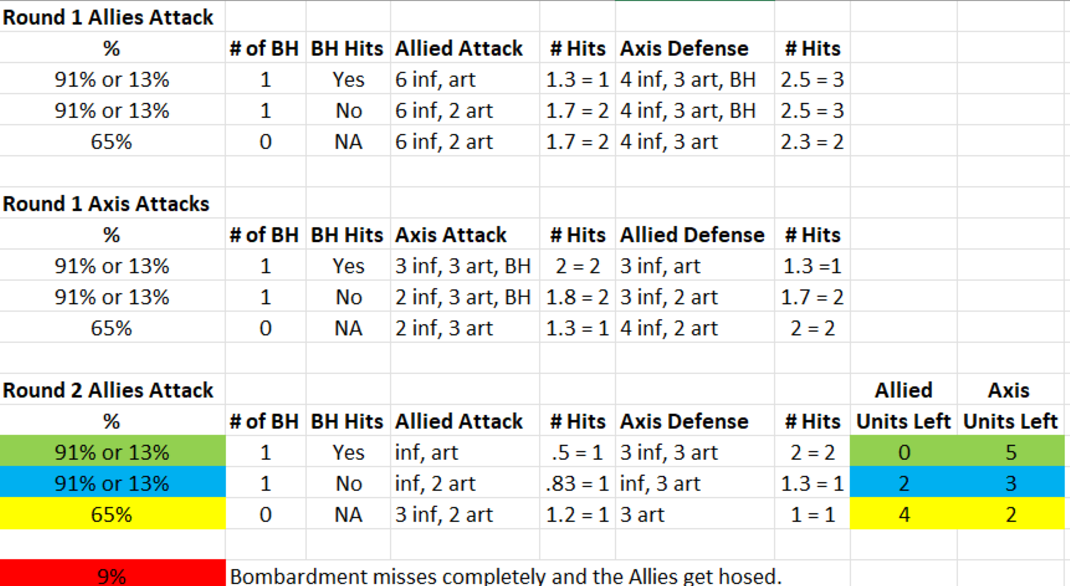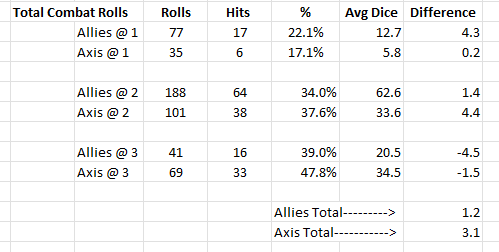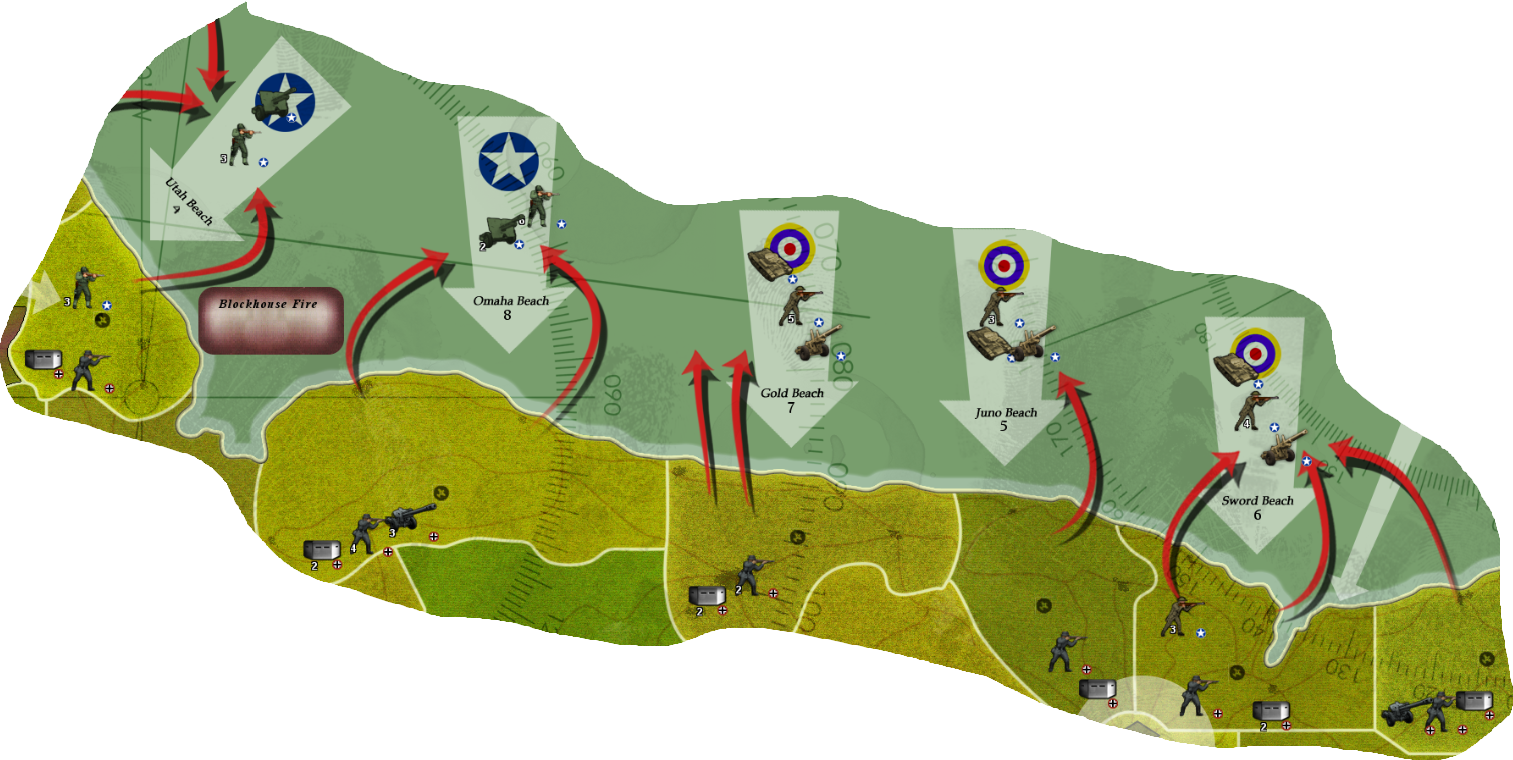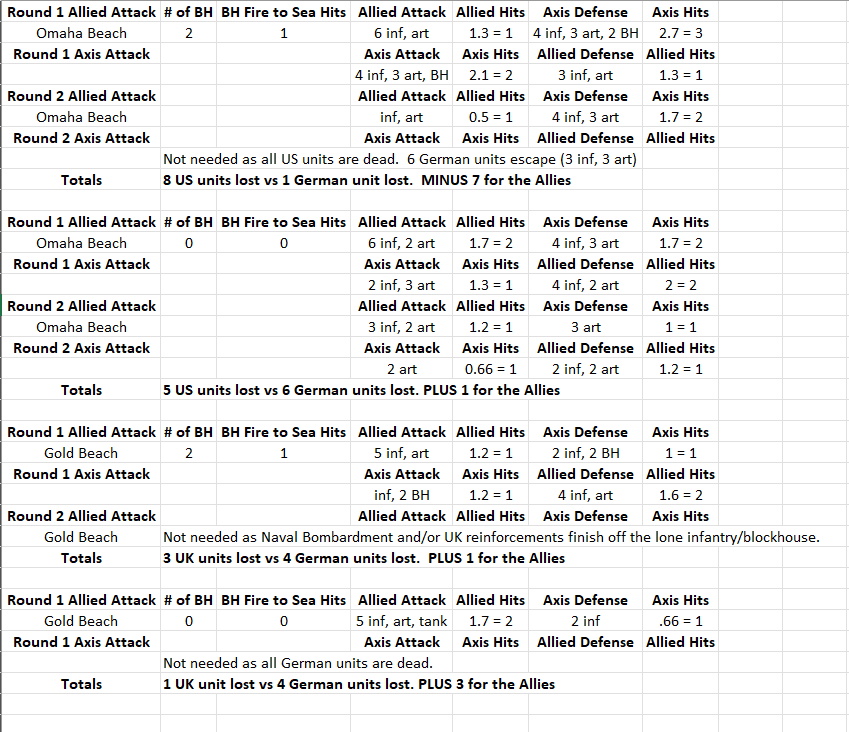Whoops went too far.
AndrewAAgamer (Allies) vs. Germany (Ragnell804)
-
G20
inf [dice 4d6<=1]
inf [dice 4d6<=1]
inf [dice 4d6<=1]
inf [dice 4d6<=1]
inf [dice 4d6<=1]
arty [dice 4d6<=1] -
4d6<=1: 5, 6, 6, 5; Hits: 0
4d6<=1: 1, 5, 5, 1; Hits: 2
4d6<=1: 2, 4, 5, 2; Hits: 0
4d6<=1: 6, 4, 1, 3; Hits: 1
4d6<=1: 1, 6, 1, 3; Hits: 2
4d6<=1: 6, 2, 6, 2; Hits: 0 -
Rolling for the units that got strafed in Caen which shouldn’t have been.
inf [dice 1d6<=1]
arty [dice 1d6<=2]
tank [dice 1d6<=3] -
1d6<=1: 3; Hits: 0
1d6<=2: 3; Hits: 0
1d6<=3: 4; Hits: 0 -
-
Okay - thank you for the test. Allies cannot take Caen this Turn so the game is over.
We proved the game is balanced. Appreciate your time in checking this…
-
Balanced??? Please explain this logic that you somehow formulated off of 1 game.
-
You don’t see it is balanced? Interesting.
The Allies had an outlier at a start in the most important battle of the game; Omaha Beach. As you can see by the chart below 65% of the time no German units escape from Omaha Beach. Add in another at least 5%, from the Blue 13%, and that makes it 70% of the time no German units survive Omaha Beach. This, BTW, matches my DDay gaming experience.

In our game 6 German units survived to fight on, only a single unit was killed. That means, at the start of Turn 2, the Germans had 6 MORE units on the board than they should have 70% of the time. At the beginning of Turn 9 there are 14 German units still on the board, one being a blockhouse so really only 13 combat units. Thus, without those 6 extra units there would be only 7 German units on the board which means the Allies would have won.
The above is not even taking into consideration that the Germans had 6 more units firing at the Allies during the game which obviously would have had an effect too.
And, since the overall dice came out fairly even, the dice during the game was not affecting this sole outlier. As you can see the Axis shot slightly better than the Allies…

-
First, the Axis will typically have 2 BH to fire onto the US units there. Every Allied player I have seen until you have used the Naval Bombardments to clear out the UK beaches to try and save the tanks from being destroyed, as it happened in this game. Because why would anyone not want to protect 3 of 14 available tanks, most of which do not get onto the board until the middle part of the game?
That, in my opinion, shows some difference in experience since the allied tanks are a valuable resource to protect.The main point here is that, with your math, the odds of the US having more than 1 arty walk into Omaha are 50% at best. And the Axis mostly have 2 BH to fight with, which changes your numbers.
Second, there is approximately a 33% chance that 6 dice rolling for a 1 will miss, which is common enough to say your attack into Omaha, at least with the inf, was not getting hosed by missing. But the Germans getting slightly warm dice, added to the lack of hits.
Third, I did not have 6 more units on the board. Those 6 units were on the board from the start, and Omaha Beach is not set up for the Allies to walk over like Juno and Sword Beach. Using your logic, those units walking away from the beach also led to more Allied units surviving later in the game to fire more since you did not have to fight through them on the first few turns. As you would have in most other games. Your math also fails to consider that I can bring a tank, inf, or arty in on G1 to help push the odds in my favor to get those units free from the locked battle at Omaha. Which again changes your math and leads to their escape or the UK having to come in to bog them down again which affects you ability to power project to Caen.
Yes, I had fewer German units on the board. But my play was also based on what resources I had available. Should I have had fewer units at my disposal, I would not have made the earlier attacks that I did since I could see from the board state at round 5, I was in a winning position.
This was one game, so how can you say the game is balanced? Based on the results thus far the game is 100% in favor of the Germans as they are 1-0 right now. Why don’t we play another to put your money where your mouth is to see if you can make it 1-1?
-
@Ragnell804 said in AndrewAAgamer (Allies) vs. Germany (Ragnell804):
First, the Axis will typically have 2 BH to fire onto the US units there. Every Allied player I have seen until you have used the Naval Bombardments to clear out the UK beaches to try and save the tanks from being destroyed, as it happened in this game. Because why would anyone not want to protect 3 of 14 available tanks, most of which do not get onto the board until the middle part of the game?
Ahhh, so your test group unanimously didn’t attack Omaha Beach. That explains a lot. I got into this testing of DDay because The Good Captain was expressing how unbalanced the game was. That the Germans win 80-90% of the time. That did not dovetail with my playing experience so I watched his DDay Axis and Allied best strategy videos. From what I saw the Axis strategy was sound but the Allied strategy was definitely lacking which I figured accounted for the difference in playing results. Now knowing, if all the testers did not attack Omaha Beach blockhouses with the Naval Bombardment, then that is a big reason why the Allies are having trouble winning.
That, in my opinion, shows some difference in experience since the allied tanks are a valuable resource to protect.
I agree, it does show the difference in experience, but in my favor, not yours.
If you look at this in detail, screenshot below, you can see there are five beach battle areas on Turn 1. There is a 64.9% chance that the Naval Bombardment will result in 2 hits. Your suggestion is to use those 2 hits on the 3 UK beaches due to “Because why would anyone not want to protect 3 of 14 available tanks,”. First off you cannot protect all 3. At best you are going to protect 1. So which one? There are 9 UK units available for Sword Beach and 3 blockhouses firing into them with just 2 defenders so certainly not that one. Juno Beach has 5 UK units with only 1 blockhouse firing into it and only 2 defenders so that looks like a good one to ignore too. Gold Beach looks like the prime spot due to the two blockhouses and 6 UK units attacking 4 units. Thus, killing those 2 blockhouses will help the landing force probably the most.

Okay, so let’s compare the average results if we kill the 2 blockhouses on Omaha Beach versus killing the 2 on Gold Beach. We are going to go out to the end of the German 2 Turn because the earliest US reinforcements can get to Omaha Beach are on Allies 3.

As you can see by attacking the UK Gold Beach you have a 2 unit swing. However, if you attack the US Omaha Beach you have an 8 unit swing. Last time I checked 8 units was better than 2 units even if one of the 2 units is a tank. Therefore, based on your testing group, there are SIX fewer Allied units on the board fighting the battle than you could have had if you had made the proper Turn 1 attack. That is a BIG DIFFERENCE!!!
This was one game, so how can you say the game is balanced? Based on the results thus far the game is 100% in favor of the Germans as they are 1-0 right now. Why don’t we play another to put your money where your mouth is to see if you can make it 1-1?
Sure, happy to play another; as long as we use Average Dice. Pure Luck proves nothing for testing.
-
@AndrewAAGamer I advocate for shelling Omaha beach. That’s covered in the videos. I also cover why some feel shelling the UK beaches is preferred. Please calm down or at least leave me out of whatever this is - there’s too much wrong. Thanks.
-
Looking over the game I just realized that is not a German tank sitting in A29 locking the US in combat, as I thought, it is a US tank. Therefore, not matter how small there is still a chance for an Allied victory so I will play out 1 more Turn.
-
OK - still can’t win. Thanks…
-
Ok, I’ll ask. How do you determine or play by avg dice?
-
I can follow and agree with your reasoning everywhere, except here.
@AndrewAAGamer said in AndrewAAgamer (Allies) vs. Germany (Ragnell804):
Thus, without those 6 extra units there would be only 7 German units on the board which means the Allies would have won.
That’s a massive assumption. Why so certain of this? Ragnell pointed out he adapted his German strategy to this game, knowing the Allies had an “outlier” on Omaha Beach. Therefore because of his experience, he knew the Germans could afford to be more aggressive than usual and still prevent the Allied win, resulting in the low Axis piece count in the end.
If this outlier didn’t happen, the Axis would have played more defensively, trading space for time and keeping the option open of making an attack on one of the victory cities with the goal of contesting it on the very last turn with decent chances, which is part of the reason why I think this game is imbalanced in favor of the Axis.
So therefore I think it’s wrong to say D-Day is balanced after just one game. I’ll believe you once you’ve played at least 10 games and managed to win 3 or more as the Allies. I am happy to present myself as an opponent.
-
@The_Good_Captain said in AndrewAAgamer (Allies) vs. Germany (Ragnell804):
@AndrewAAGamer I advocate for shelling Omaha beach. That’s covered in the videos. I also cover why some feel shelling the UK beaches is preferred. Please calm down or at least leave me out of whatever this is - there’s too much wrong. Thanks.
a) I am calm, I am addressing the point presented by Ragnell804 in a logical manner so not sure where that is coming from. b) It does not matter what you expressed in your strategy video. Ragnell804 said he has never seen Omaha Beach bombarded in his tests game which means your test games are flawed.
-
@VictoryFirst said in AndrewAAgamer (Allies) vs. Germany (Ragnell804):
I am happy to present myself as an opponent.
Actually, we only need one using Average Dice. Are you up for that?
-
@Ragnell804 said in AndrewAAgamer (Allies) vs. Germany (Ragnell804):
How do you determine or play by avg dice?
Average Dice show the average number of hits based on the number of targeted units available. For example, 2 3’s plus 6 1’s are attacking 6 units. Average Dice say this is 2 hits. However, reduce the target units to 2 and the average dice changes to 1.6. You can easily represent this by putting the battle into a Battle Calculator and choosing 1 combat roll of dice. The result is average dice. Using this method we capture the average results in every battle based on all possible outcomes.
The issue with Average Dice is it overrepresents misses in small battles. Take that same battle as above and put in 1 target unit and the result will be 0.92 unit. Due to the chance of ANY miss Average dice will never give you 1 hit based on 1 target unit since there is always a chance the dice will miss.
Since in DDay there are a lot of 1 unit defensive battles, due to Fighters and AAA, we shouldn’t use average dice in those battles. Instead, the way to accommodate this issue is to use a targeted percentage of what constitutes an average hit. Using the Bell Curve we know that 68.2% of all results fall into 1 Standard Deviation. Since we are testing we want any result to at least cover that percentage. To achieve at least a 68.2% percentage for 1’s we need to adjust it to 7 rolls equals 1 hit (72%).
There are details as to how to implement this methodology for testing and if you are interested I will post them too before we begin.
-
All understood, however when applying losses do we just round the Average Hits to the nearest whole? If consistent rounding up or down is applied then that creates the possibility of one side gaining an advantage over the other, however I assume you have a way to take that into account.
One game is fine, I am curious to see how the game will go with average dice. However regardless of the outcome it will not convince me of anything. A game will never be completely average, there will always be some up and downs for both sides in some cases and that also has an effect on the balance. For example, the Allies could be more susceptible to bad rolls than the Germans. And not to forget, risk also takes part in this. It can have a large impact if you already know what the final result of a battle will be before it takes place. It changes playstyle and strategy. Only a large number of games with standard rules will convince me.
Yes, please share the details of your methodology, thanks. However I think it’s best if you that in a separate thread.
-
@VictoryFirst said in AndrewAAgamer (Allies) vs. Germany (Ragnell804):
However regardless of the outcome it will not convince me of anything. A game will never be completely average, there will always be some up and downs for both sides in some cases and that also has an effect on the balance.
Oh YES! Don’t think for even a second I am thinking games will be average. In fact, we KNOW they will not. Therefore, with even Dice, the Allies HAVE to win, otherwise the game is definitely unbalanced in favor of the Axis.
Just like Global 1940 the Allies have to win more than the Axis. In Global 1940 the Allies have to win on BOTH sides of the board; whereas the Axis only one to win on ONE side of the board. Thus, in Global 1940, for the game to be even, the Axis can only have a 37% chance of winning on either side. (37% plus 23% = 50%)
It is even worse in DDay. For me, I think there are 4 parts:
- Early game (Rounds 1, 2 and 3)
- Cherbourg
- St. Lo
- Caen
The Allies have to win in all 4 parts, the Germans only have to win in one. BTW I think an argument could be made that Caen and St Lo might be 1.5 instead of 2 due to they are kind of close but only tanks can move back and forth so I like to count it as two separate areas.
Therefore, the question is how much bad luck can the Allies take and still win? That is what the testing is for.
For example: Let’s assume the Allies win 100% of the time when they get fair dice. But they lose 20% of the time when they get bad dice in one area and they lose 60% of the time when they get very bad dice in any one area.
Looking at the Bell Curve = 15% low, 70% even, and 15% high. If we define Bad dice as getting less than your opponent and Very Bad dice as getting 2 levels of dice below your opponent then using this matrix we get:

Bad Dice = 10.5% + 2.25% +10.5% = 23.25% x 20% = 4.65%
Very Bad Dice = 2.25% = 2.25% x 60% = 1.35%
4.65% + 1.35% = 6%
Times four areas = 24% of the time the Axis wins.So, the testing is really to try and give us an idea of how easily the Allies win with fair luck to see how much bad luck they need to lose.






